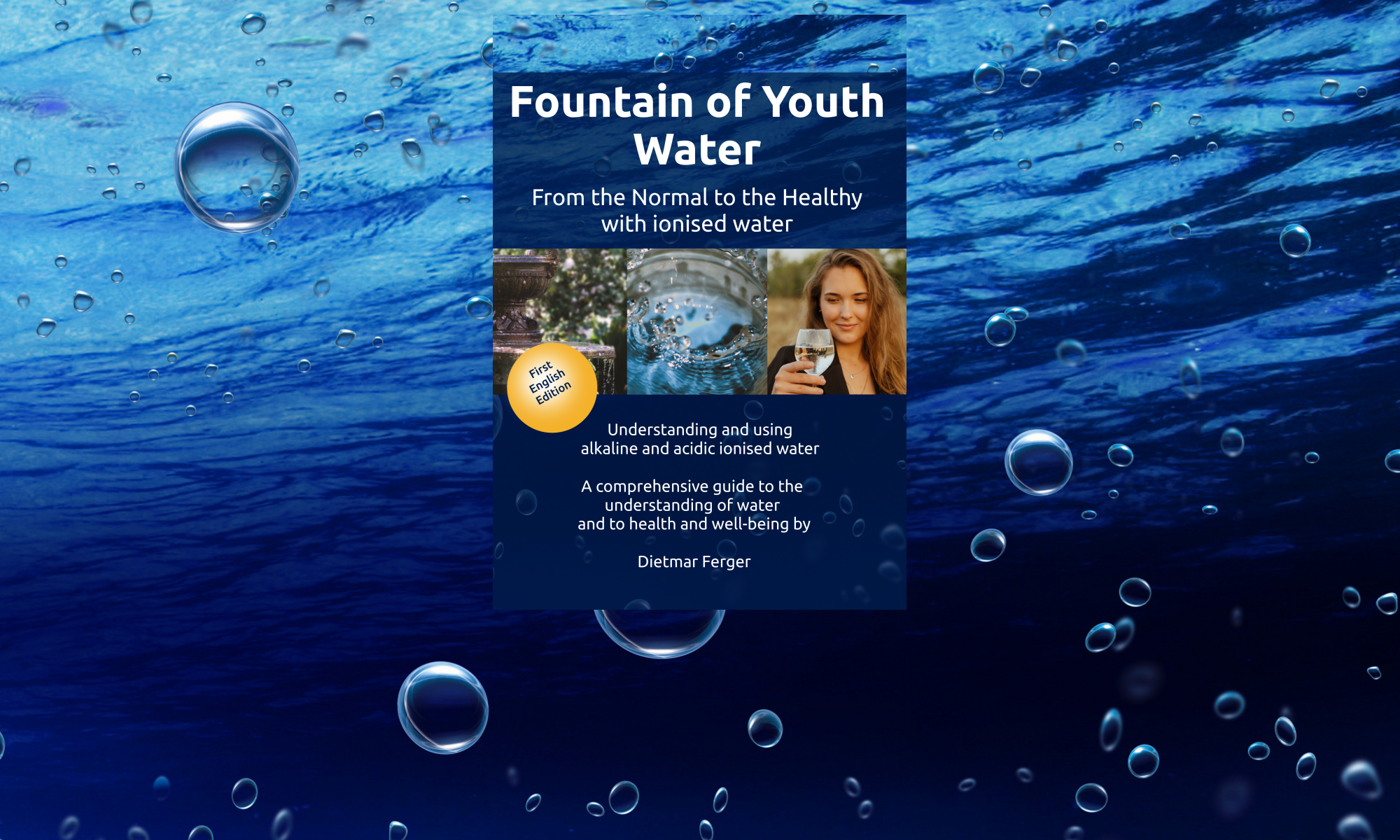Some English-speaking friends convinced me to translate my book „Jungbrunnenwasser“, which has been sold in its German version up to now in nearly 20.000 copies and is now in its seventh edition.
Water is a fascinating element. Researching this topic for many years, I have met scientists who have been intensively involved with water for decades – and are still at the beginning of their research. Therefore, a book about water can only be a provisional appraisal and represent the current state of knowledge.
This book is about “ionised water”, a machine-made, functional water with properties that are very useful for nature and mankind.
Albert Szent-Gyorgyi M.D., the Nobel laureate and discoverer of Vitamin C, wrote that “ageing symptoms … are always associated with a slow shrivelling of our living tissue, accompanied by damage caused by reactive oxygen species (ROS)” – we know today that alkaline ionised water permanently hydrates the body tissues and neutralizes ROS with gaseous hydrogen. So, it is certainly not presumptuous to call it “Fountain of Youth Water” … Soviet scientists who researched it before Perestroika even called it “The Water of Life“.
The ionisation of water is a “treatment” of water with technical or natural electric energy, being among the most significant developments in the diverse “water markets” since the development of reverse osmosis technology. It is interesting to note that the intense Soviet Russian research on ionised water was simply stopped after the collapse of the Soviet Union, and that the development in Japan and Korea led to technical perfection over decades without anyone in the West noticing. Except for a few lectures by Japanese scientists at international congresses, for a long time there were no scientific sources that were accessible without Japanese or Korean language skills.
In 1990, the book “Reverse Aging” opened the “Gate of Knowledge” for the English-speaking world. The author Sang Whang (†), an American engineer of Korean descent, was able to evaluate the original sources and embed them in a Western scientific context. I translated it into German and published it in 2002.
Since understanding the book “Reverse Aging”, I see it as my task to inform scientists, politicians, therapists and consumers about alkaline ionised water and its positive potential for the rehabilitation of our prohibitively expensive public health, for the prevention of increasing lifestyle and geriatric diseases and for the optimization of human health and zest for life.
Since 2003, we are drinking alkaline ionised water and, since 2016, hydrogen water. Our kids never wanted to drink Coke or other soft drinks and hardly needed any sick-leave from school.
Other users report success in the development of their health and performance, like cellulite disappearing within 4 weeks, bedridden patients becoming active again, high blood pressure or intraocular pressure going down, and far more.
Mainly Japanese studies have shown that alkaline ionised water and hydrogen water are not only simple and effective methods of prevention – if prevention is not only understood as a series of more or less meaningful vaccinations or preventive screenings for early detection of diseases –, but also supportive in the treatment of lifestyle and geriatric diseases.
Although alkaline ionised water and hydrogen water can be effective, simple and cost-effective means of health care and enhancing quality of life and performance, they are not (yet) recognized in the “western” medicine, as no studies accepted by the rules of the western scientific community have been carried out. It is therefore important to stress that the findings cited in this book are based on own or third-party observations, reports and conclusions, but not on studies recognized in “western” science.
Therefore, this book is not intended to replace a doctor or therapist who should always be consulted on acute or chronic conditions.
The ignorance of western science and society also has far-reaching consequences for nature and the environment, because the use of anolyte and catholyte in agriculture and animal breeding and also the use of anolyte as a highly effective and side-effect free disinfectant in hospitals and – as in the fight against the corona virus in China – in fighting epidemics would avoid the use of antibiotics and chemical disinfectants, which in the long term and persistently contaminate water, soil and the environment.
With this in mind, I wish you an interesting read with the request that you pass on or recommend this book to people who are interested in holistic health and preserving the environment. It is not without reason that most of the Korean and Japanese households nowadays are equipped with a water ioniser or another similar device for treating and enhancing their drinking water.
Dietmar Ferger
environmental engineer and preventologist

